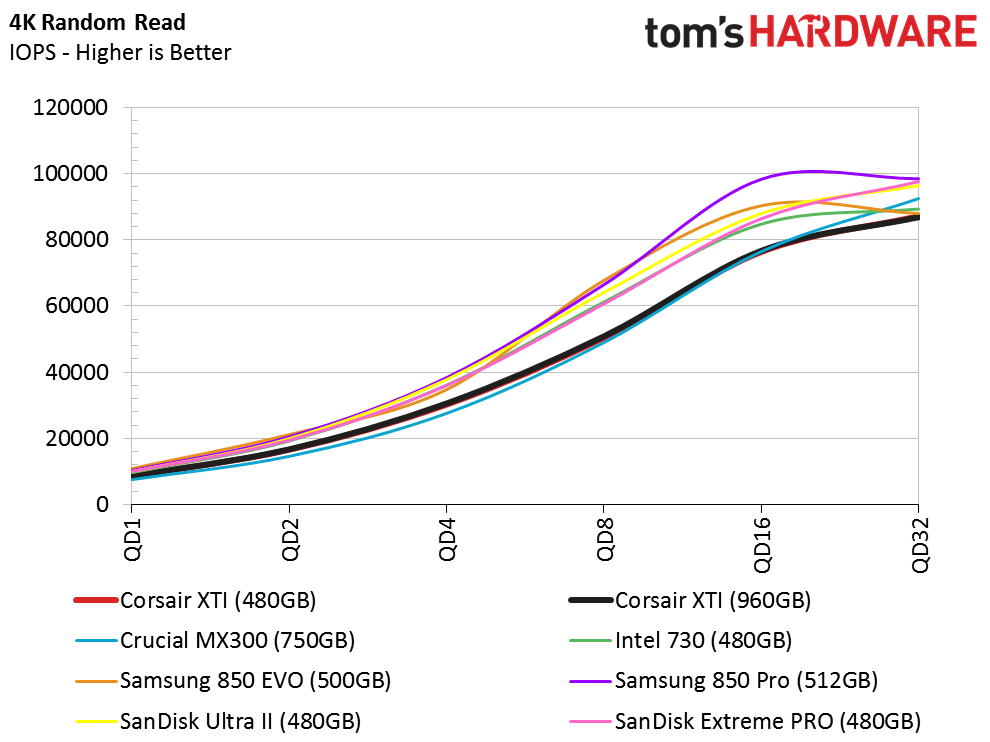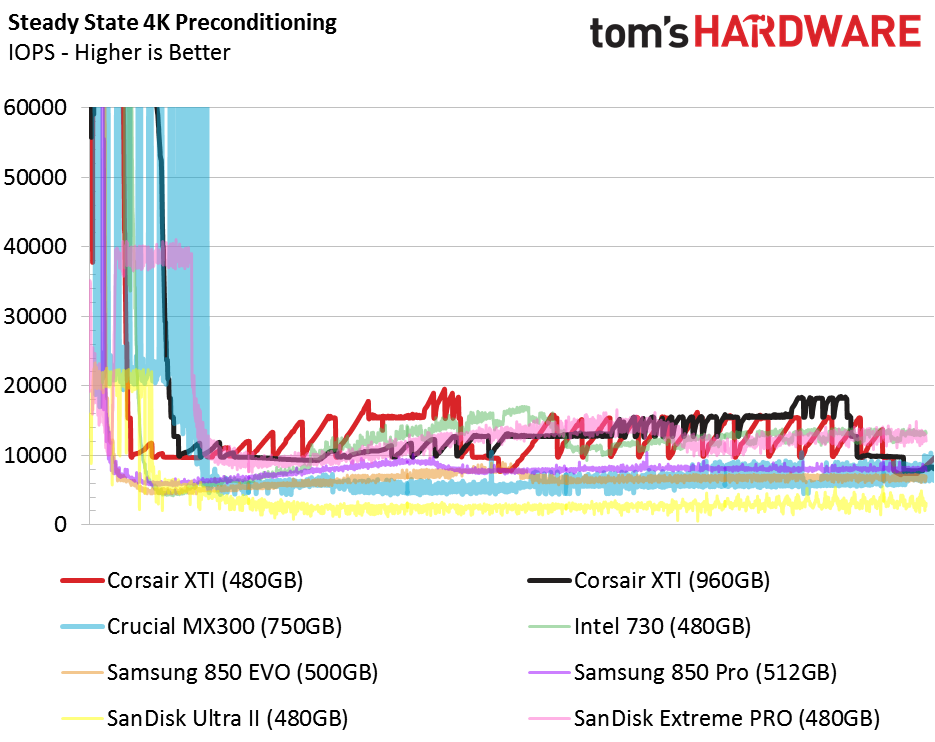Corsair Neutron XTi SSD Review
Why you can trust Tom's Hardware
Benchmarks And Comparisons
Comparison Products
The Corsair Neutron XTI series is our first high-performance SATA 6Gbps SSD review in some time. We created a diverse mix of mainstream and premium products for the test pool used in this review.
The Samsung 850 Pro and SanDisk Extreme Pro dominate the high-performance SATA market. Both ship with a 10-year warranty and deliver the highest performance in this category, but we prefer the Extreme Pro for its class-leading performance consistency under heavy workloads. The Intel SSD 730 falls in the same category, but it is often overlooked due to its high price and shorter warranty period.
The Samsung 850 EVO dominates the mainstream SSD category with a comparatively long 5-year warranty, impressive performance and legendary reliability. The SanDisk Ultra II and the 750GB Crucial MX300 round out the list of 512GB-class SSDs.
To read about our storage tests in-depth, please check out How We Test HDDs And SSDs. Four-corner testing is covered on page six of our How We Test guide.
Sequential Read Performance


Most of the products in the chart deliver impressive sequential read performance. The last few Phison firmware releases have lowered sequential read performance by 20 MB/s at queue depth 2, but the slight reduction is of little concern in light of the still-impressive level of performance.
Sequential Write Performance


The Corsair Neutron XTi 480 GB dominates the sequential write performance test, but many of the SSDs trail close behind. The write workload is the second test where the smaller capacity XTi overshadows the larger model, which has more flash and DRAM. The big performance from the small package is noteworthy because the larger SSDs usually outperform the smaller ones.
Random Read Performance



Not even Corsair with its double-dose of DRAM could nudge the Phison S10 up to 10,000 random read IOPS at queue depth 1. Phison has worked hard to increase random read performance over the last year, and we've noticed some modest gains in this area, but it is not enough to match Samsung's premium and mainstream SSDs.
Get Tom's Hardware's best news and in-depth reviews, straight to your inbox.
The XTi products trail every other SSD on the chart in small block random read performance, with the exception of the 3D TLC-powered Crucial MX300 (which has a 4-channel controller handicap). The random read performance is disheartening and will show up later in the review as we examine workloads that are more advanced.
Random Write Performance



The Neutron XTi's random write performance also trails the other SSDs at queue depth 1. The XTi SSDs do a little better as we move higher up the depth range, but performance parity with the best SSDs doesn't come until the high queue depths.
80 Percent Sequential Mixed Workload
Our mixed workload testing is described in detail here, and our steady state tests are described here.
The XTi's high sequential performance carries over to the 80 percent mixed workload. At queue depth 2, the XTi SSDs are close to the Samsung 850 Pro and manage to match the 850 EVO. The Neutron XTi SSDs increase their sequential performance as the workload intensifies and remain competitive throughout the remainder of the test.
80 Percent Random Mixed Workload
The low random read performance takes a heavy toll on the Neutron XTi's mixed small block performance. Historically, this is the one area that Phison struggles to master, and the company has suffered from the low mixed random performance for several product generations. On the next page, you will see how subpar mixed random performance affects real world applications, which often consist of a heavy concentration of 4KB random blocks of data that the operating system loads into memory.
Sequential Steady State



Phison's S10 firmware team has spent a lot of time increasing the sustained steady-state performance for enterprise applications, and the Neutron XTi gained some performance increases from progress in that area. Most users will never encounter an intense steady state condition without using extreme corner case workloads, such as very heavy A/V production on a computer that is dedicated solely to that purpose.
Random Write Steady State


The Corsair Neutron XTi SSDs have the most consistent 4KB random write performance of any consumer SSD we've ever tested, which is a direct side effect of the new double-DRAM configuration. Consistent performance doesn't mean high performance, though. The Neutron XTi SSDs offer incredibly consistent performance, but they only deliver half the random steady-state IOPS of the Intel SSD 730 and SanDisk Extreme Pro during this test.
Current page: Benchmarks And Comparisons
Prev Page Specifications And Features Next Page Performance And Conclusion
Chris Ramseyer was a senior contributing editor for Tom's Hardware. He tested and reviewed consumer storage.
-
Kimonajane Too expensive still. Better having a smaller SSD for programs and using big platter drives for storage. I don't know why the average Joe needs so much storage anyway. I guess if you digitally download movies or take many high resolution pictures. There is where cheap platter drives still win. Use one always for backup too.Reply -
Sakkura High-end SATA SSDs have been a little pointless (for consumer use) for a long time, but it's only getting worse as PCIe storage proliferates. Right now, 99.9% of people should either get an affordable mainstream/budget SATA SSD, or if they really need the speed, go for an M.2 PCIe (or U.2 or PCIe AIC) SSD. If you're gonna pay for a premium product, you might as well go for what's actually considerably faster across the board, rather than this kind of half measure.Reply -
chalabam Most drives are now bottlenecked by SATA.Reply
And because a lot of people cannot change the motherboard to get no SATA drives, SATA drives should come with multiple parallel SATA connectors, and a software driver capable of using them to extract more speed out of the SATA interface. -
chalabam Most drives are now bottlenecked by SATA.Reply
And because a lot of people cannot change the motherboard to get M-2 or fancier, SATA drives should come with multiple parallel SATA connectors, and a software driver capable of using them to extract more speed out of the SATA interface. -
Sakkura Reply18326906 said:Most drives are now bottlenecked by SATA.
And because a lot of people cannot change the motherboard to get M-2 or fancier, SATA drives should come with multiple parallel SATA connectors, and a software driver capable of using them to extract more speed out of the SATA interface.
No point, simpler to just run them in RAID0 if you need more speed. -
deus You'll be interested to kno none of the charts display in FF 47.0.1 and the same applies to the review of the SK hynix .Reply
Charts do show in IE 11.
Nice.
Lets earn money anyway we can, eh ?




